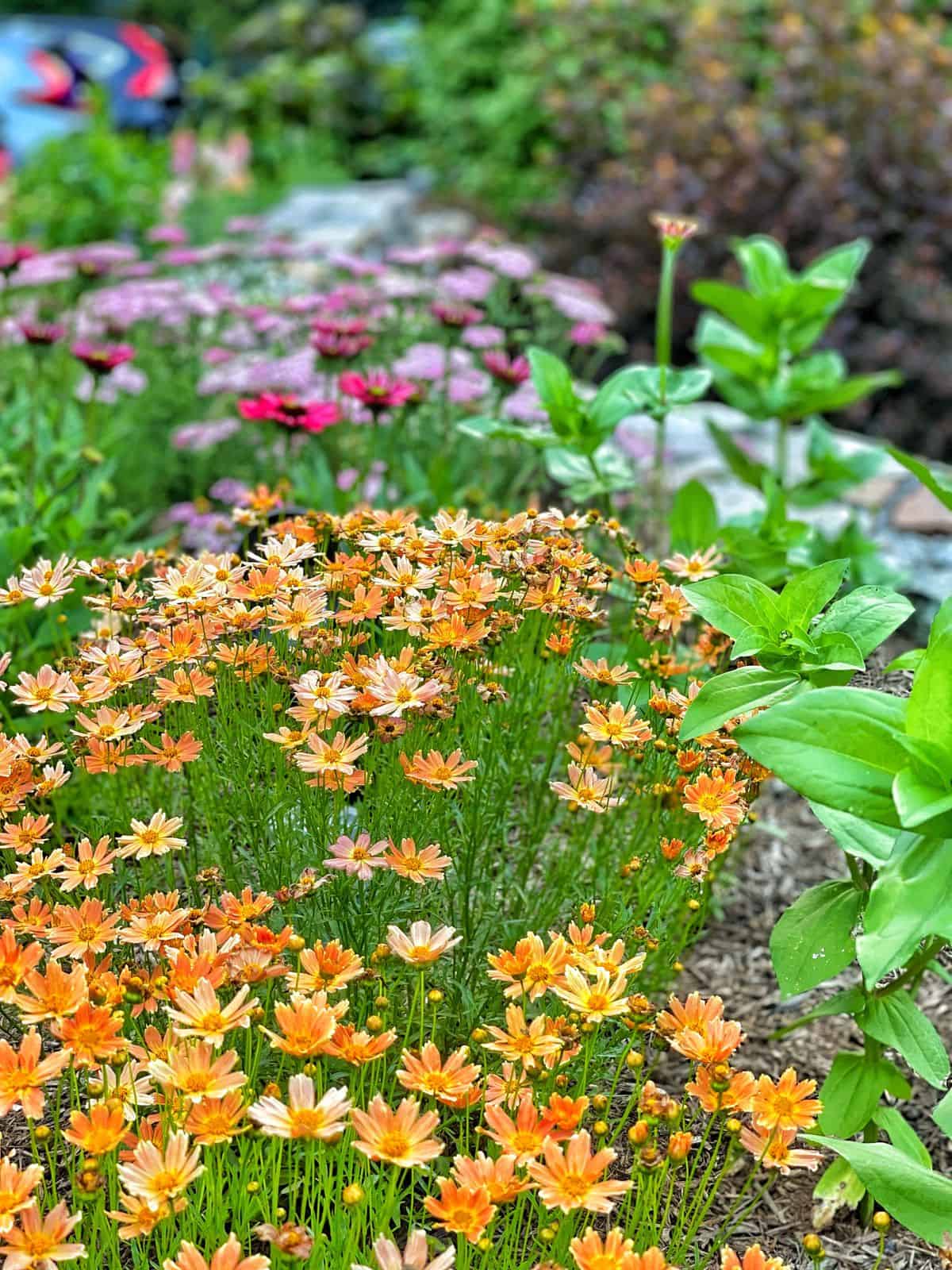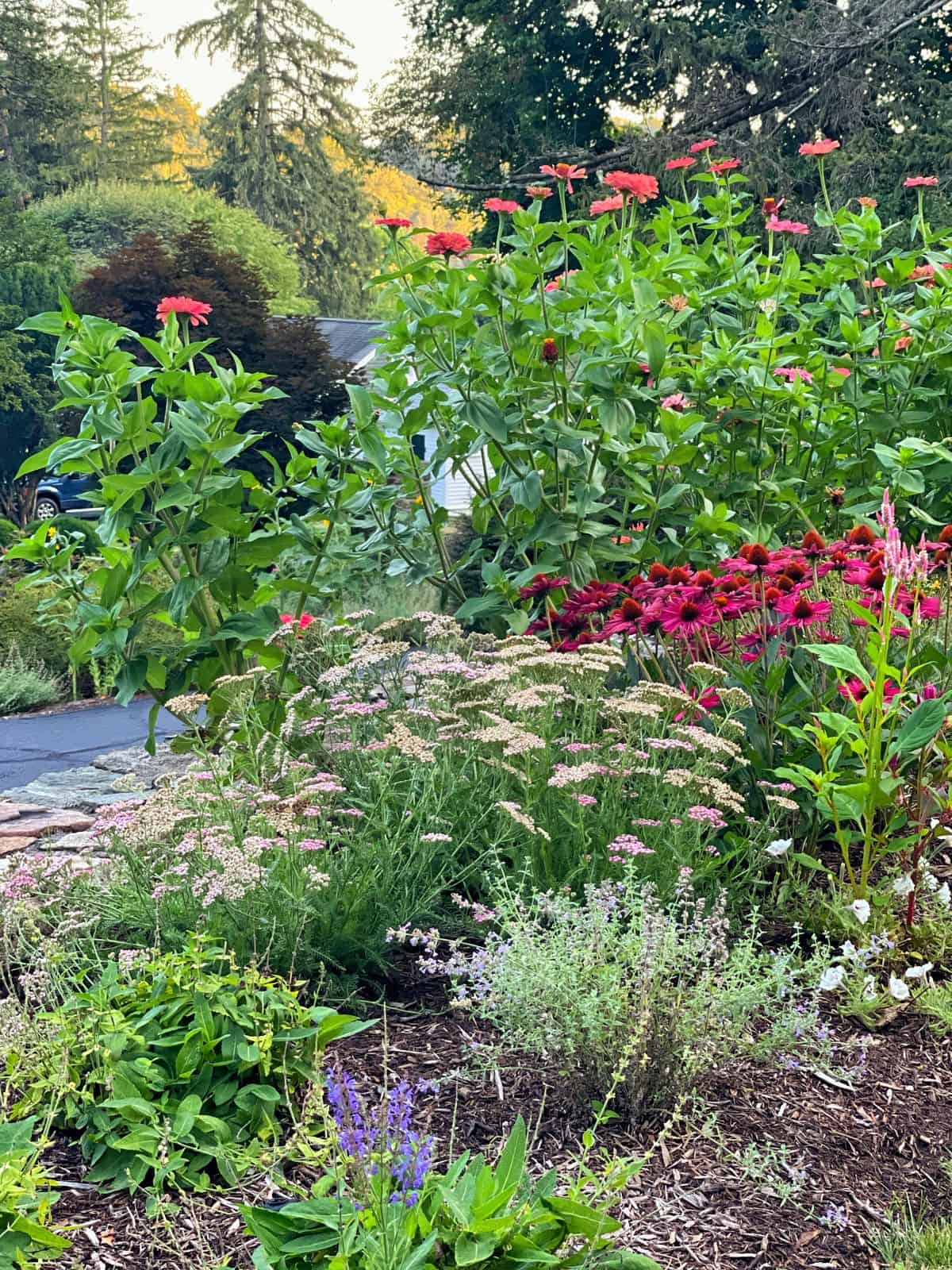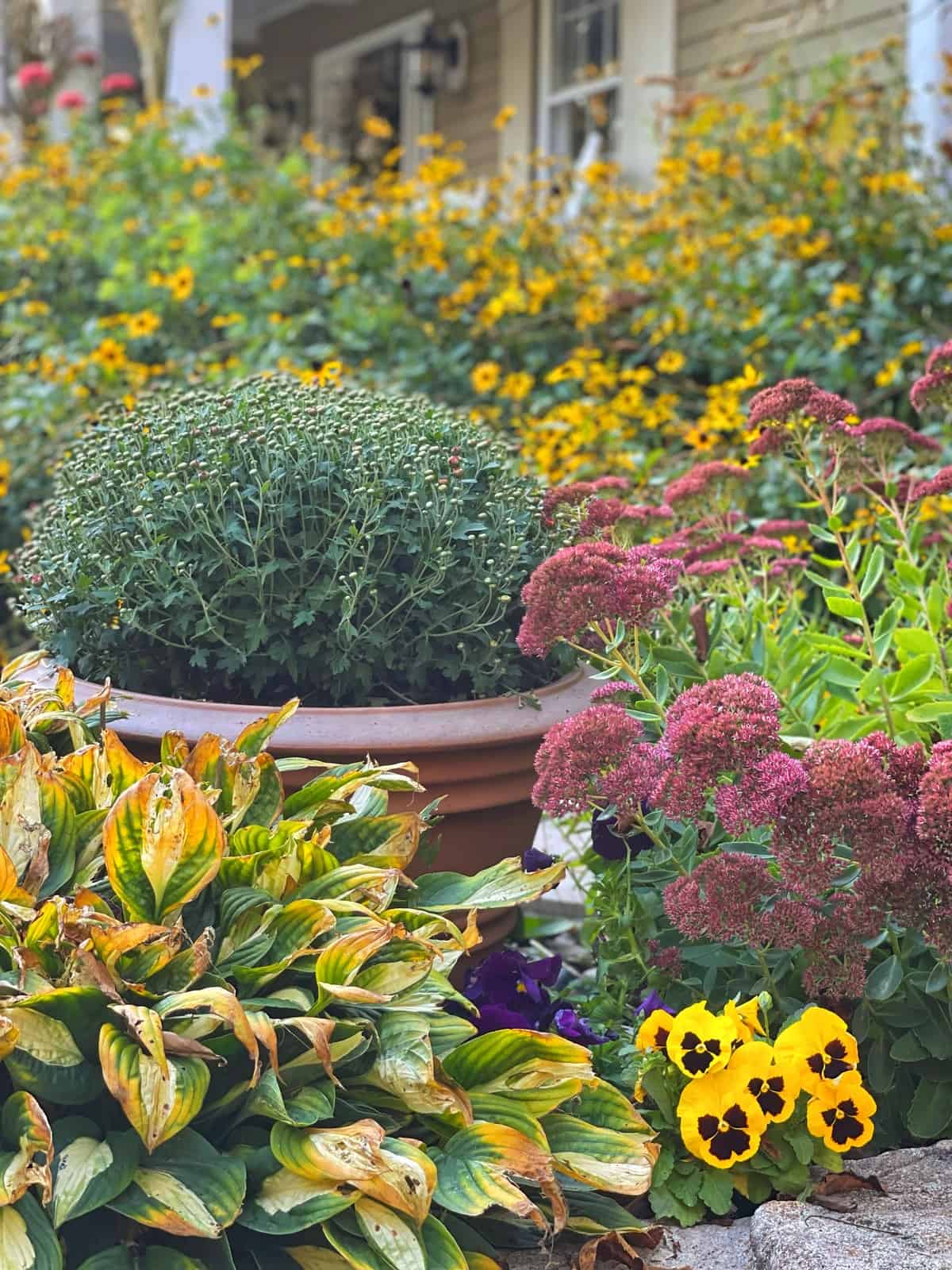Short on time? Create a charming, low-maintenance cottage garden with easy-care flowers and simple design tips.
When I started growing a flower garden, I dreamed of having one that was informal, beautiful, and easy to grow. I couldn’t be bothered with plants that were finicky, needed additional support to avoid toppling over, or needed to be dug up and stored during the winter.
Nope.
My garden needed to look beautiful, bloom like crazy from spring through fall, and be really low-maintenance.
Sound like a flower garden you want to grow too? Read on and try these easy-care cottage garden ideas this year for a low-maintenance plot that will bloom all summer.
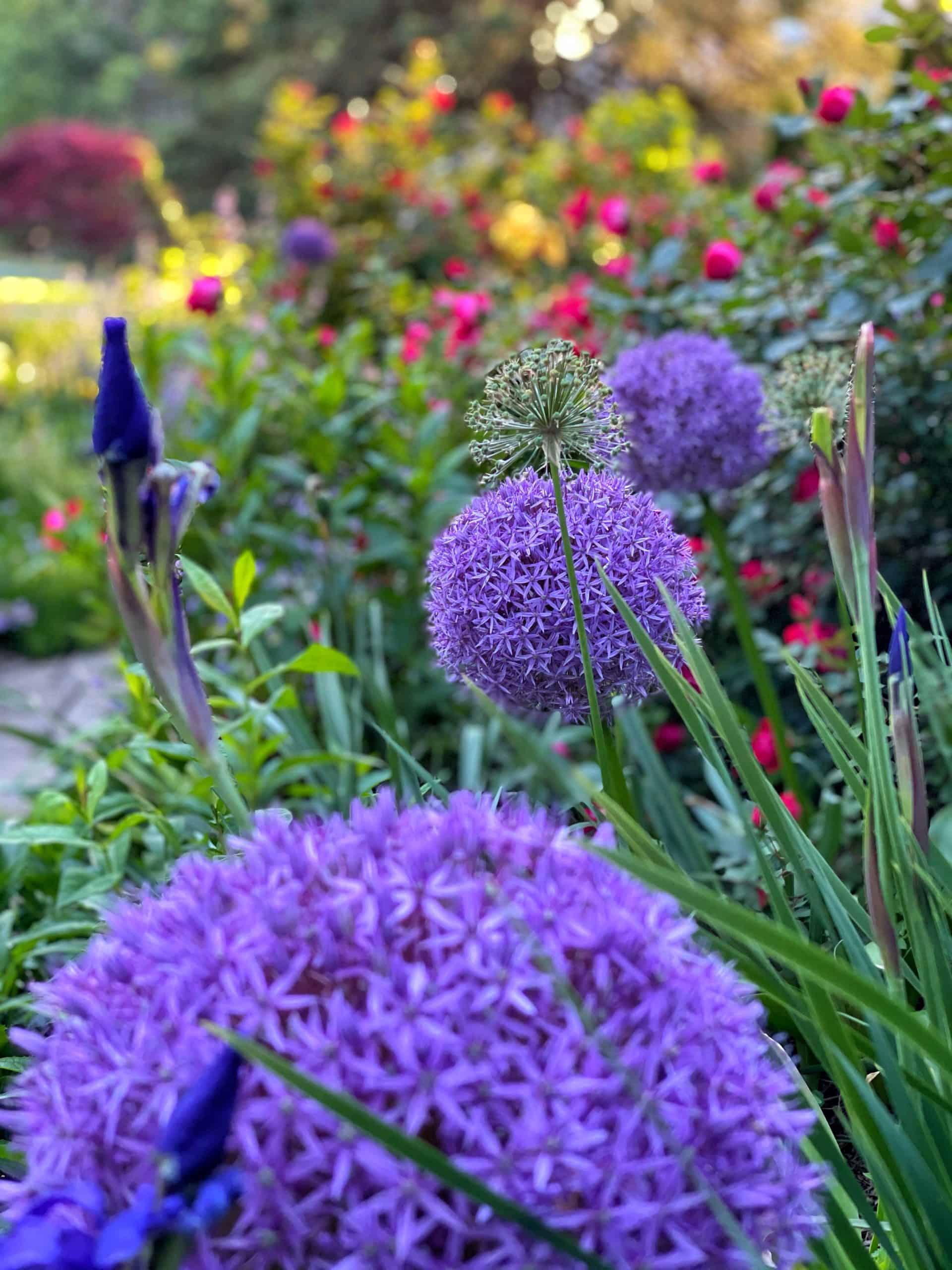
What Is a Cottage Garden?
Characterized by a charming, informal design with a mix of plants, cottage gardens evoke a sense of rustic, old-fashioned beauty that is often associated with the English countryside.
The cottage garden is not highly manicured or formal, but rather has a natural, relaxed look with plants growing in a seemingly haphazard manner. A sense of abundance is created with an eclectic mix of colors and textures that are pleasing to the eye.
Sometimes these plant combinations are intentional, but others happen by accident in the manner that flowers weave among one another. You’ll often find a mix of perennials and annuals, as well as herbs and vegetables. Many cottage gardens also include fruit trees and flowering shrubs too.
But the best part about growing a cottage garden?
It’s lower maintenance so gardeners of all skill levels can easily enjoy one. Growing a cottage garden is a great way to bring a little bit of the countryside to your home while creating a beautiful, relaxing space that is perfect for spending time with friends and family.

What is the difference between a cottage garden and a formal garden?
A cottage garden is typically a lot more relaxed and easier to maintain than a formal garden. While formal gardens may feature structured, symmetrical design and carefully-planned patterns and layouts, cottage gardens are designed to feel relaxed and natural.
Cottage gardens also typically include a wider variety of plants, including a mix of annuals, perennials, shrubs, climbers, and even herbs and evergreen plants. While it can be fun to pick a cottage garden color palette, it’s less common than when planning a formal garden.
By far my personal favorite difference between a cottage garden and a formal garden is the maintenance. While every garden needs some maintenance (such as deadheading flowers, dividing perennials, and fighting off weeds, growing a cottage garden means embracing a slightly wild and natural look that makes minor imperfections no big deal.

Easy Flower Gardening Tips for the Beginner
While we gather cottage-style inspiration, it’s important to remember that no two gardens will ever look the same. Not even the same garden will look the same from year to year as each home and garden has its own microclimate.
So as hard as we might try to replicate a look, it’s pretty likely it won’t look the same. And that’s OK! Because your garden is uniquely you.
Plants that do well for me, may not grow as well for you. The varieties I grow may not be available in your area, but the ideas are there. So take that bit of information and don’t feel discouraged if your garden grows differently.
Cause it will.
I grew my flower gardens for 23 years at my former home and let me tell you how different the gardening is here at my new house.
And I’m only 20 minutes away in the same hardiness zone!

What Makes a Low-Maintenance Cottage Garden?
For beginners, starting a flower garden from scratch can feel overwhelming. And it may be hard to believe that a low maintenance cottage garden exists. So, what does low maintenance mean when it comes to gardening?
My style of growing a cottage garden is to work with plants that are easy-to-grow, easy-to-care for, and low maintenance for you as a gardener.
They are flowers that are more pest and disease-resistant. They don’t need staking. And they bloom for a long time. For many years, I had to garden with this perspective because I had three kids to run around with and care for, I just couldn’t give that much more to my garden.
But I still wanted that old English cottage garden charm. So I learned what perennial plants looked good with less work from me overall. Now that’s not to say you won’t do anything in your cottage garden, cause you will. But it is more manageable to work with plants that grow with ease.
As my kids have grown and I’ve gained experience through the years, I’ve begun working with plants that require more time and energy from me like dahlias and other flowers I grow for cutting. So if you are just starting out, I don’t recommend these types of plants for you and want you to work with flowers that require less time from you.
Keep things easy for yourself, start small, and learn as you grow to see how much work you really want to do in your flower gardens.

Best Easy-Care Cottage Garden Flowers to Grow
After growing flowers for more than 25 years, I’ve gained experience with both easy-care and high-maintenance flowers. So, here’s a quick list of my favorite easy-care garden flowers to grow.
- Hellebores
- Creeping Phlox
- Pansies
- Daffodils
- Tulips
- Salvia
- Nepeta
- Baptisia
- Siberian and Bearded Irises
- Peonies
- Geraniums
- Petunias
- Marigolds
- Snapdragons
- Lavender
- Zinnias
- Hydrangeas
- Coreopsis
- Echinacea
- Daylilies
- Rudbeckia
- Alliums
- Sedum Autumn Joy
There are so many more to choose from, but these are some easy flowers that I regularly plant and grow in my cottage gardens because they are low maintenance and easy to grow.

Low-Maintenance Cottage Garden Ideas and Design Tips
Designing a dreamy cottage garden can be a fun and rewarding process, as it allows you to create a space that is uniquely your own. Here are a few low-maintenance gardening tips for designing an old country garden.
Choose a Mix of Flowers for a Cottage Garden in Your Hardiness Zone
As I mentioned earlier, one of the key characteristics of an old fashioned cottage garden is the mix of different plants, including annuals, perennials, bulbs, flowering shrubs, herbs, vegetables, and fruit trees.
This will give your garden a diverse and interesting look, with a range of colors and textures. So look on Pinterest. Search Google. Scroll Instagram and TikTok for ideas. Speak with other gardeners. And find what types of flowers are easy to grow that you are drawn to that will thrive in your climate.
If you aren’t sure of what cottage garden flowers work well in your hardiness zone, you can check it here.
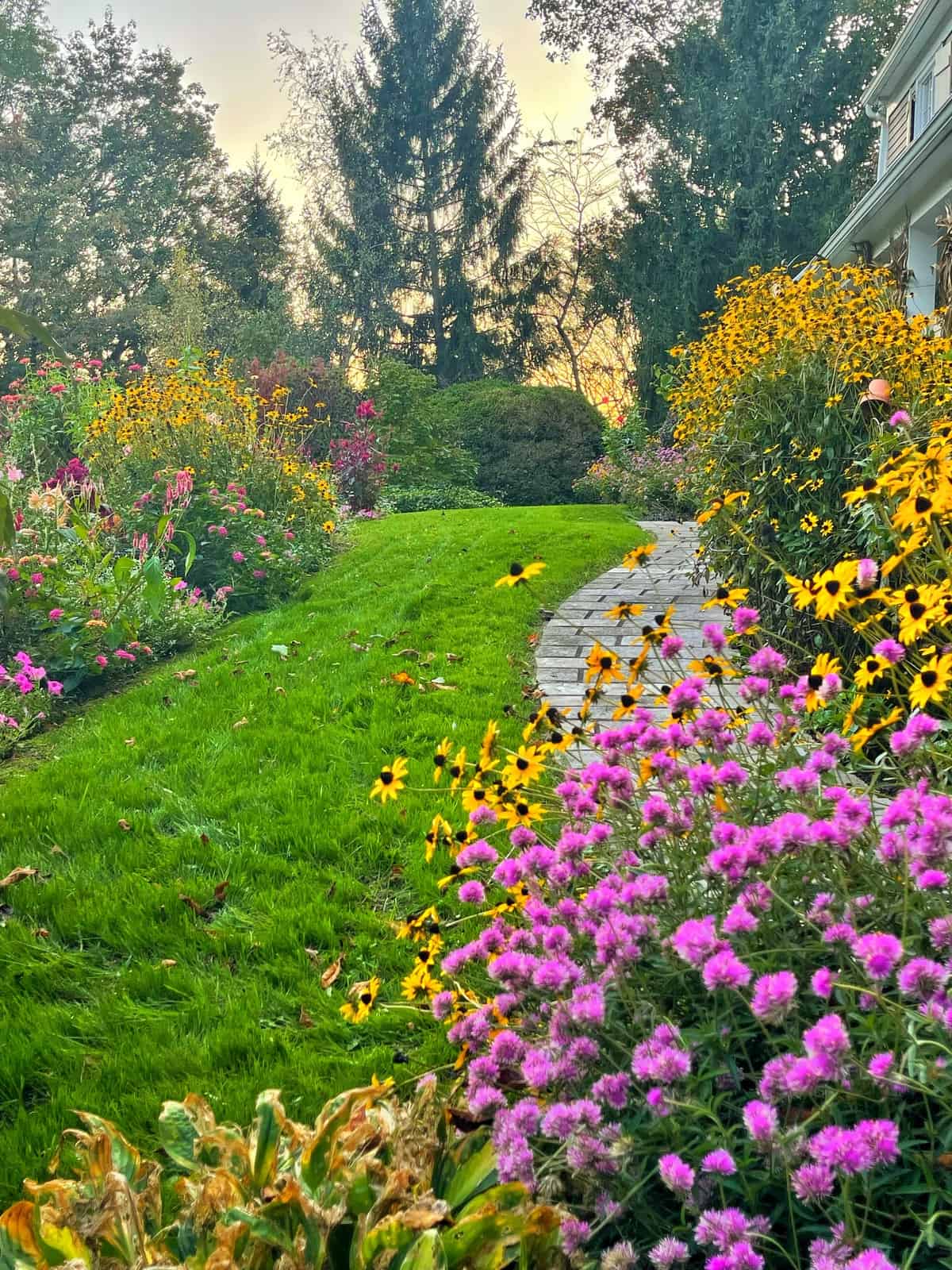
Include Evergreens in a Cottage Garden
Incorporating evergreen shrubs and even small trees ensures your garden will have visual interest – even in the colder fall, winter and early spring months. Evergreen plants are also a great buffer for seasons when your garden may be in between bloom times and looking a little less full.
Consider a Carefree Cottage Garden Layout
Old-fashioned cottage gardens often have a natural, informal layout, with plants growing in a seemingly haphazard manner. However, you can still think about the overall design and consider how you want to arrange the different flowering annuals, perennials, and shrubs.
Create groupings of plants with similar water and sunlight needs together. Most cottage garden flowers need full sun. However, you can add a cottage garden feel to a shade loving garden. Plant in odd numbers so it’s more aesthetically pleasing to the eye. I typically plant in 3’s, 5’s, 7’s, and 9’s depending on the size of the garden and plants I’m using.
Create a focal point with a larger plant or structure and then design your flower garden around it.
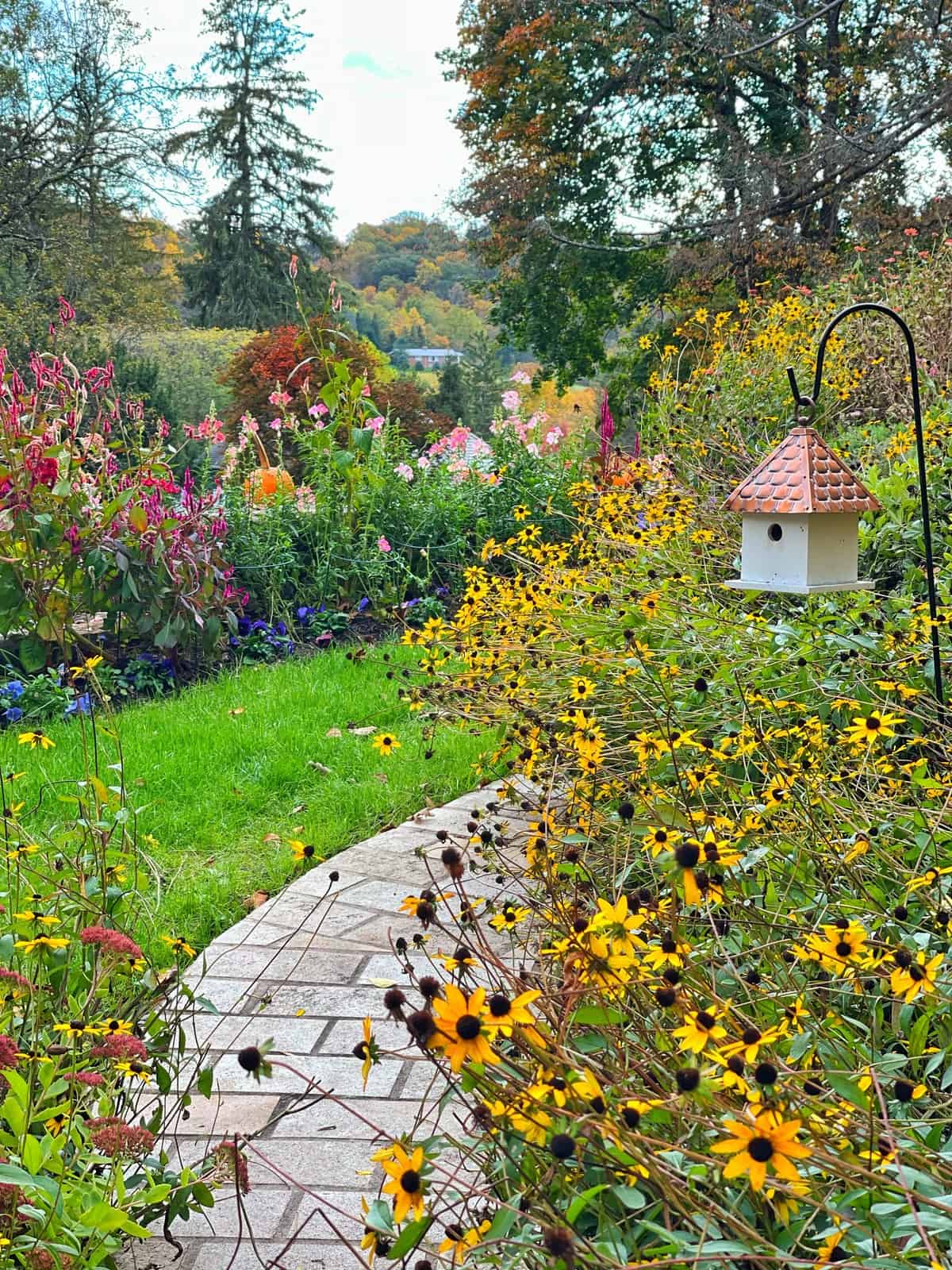
Add Vertical Elements
To add depth and interest to your old country garden, consider including some vertical elements, like trellises, arbors, or obelisks. These can provide support for climbing plants and create a sense of height and structure within the garden. Plus, it gives the eye a place to rest when looking at the garden.

Use Natural Materials
To enhance the rustic, old-fashioned feel of an old English cottage garden, consider using natural materials such as wood, stone, and clay in your design. Include a wood picket fence to define your garden, add layers of plants and flowers, and create defined boundaries. Or make a beautiful stone pathway to create a charming and inviting look that adds lots of cottage garden style.

Create Pathways in Your Cottage Garden Design
Lay down gravel or stepping stones for pathways winding through your garden and create a charming and inviting look that adds lots of cottage garden style. Pathways also add some structure to a cottage garden (without feeling too formal) and can even make maintenance easier by helping you access plants in different parts of the garden.
Create a Seating Area
The only thing better than growing a cottage garden is enjoying it! Create seating areas in or next to your garden to ensure you can take in its full beauty all summer long. Add a small garden bench alongside a pathway or set up a full patio table adjacent to the garden.
Plan Around Bloom Times
If you want your garden to look beautiful and colorful for as many months out of the year as possible, then it’s important to choose your plants and your cottage garden layout based on bloom time. Use a mix of early-blooming spring bulbs, as well as annuals and perennial flowers that bloom in late spring, throughout the summer and even into fall.
I like to plant summer-blooming flowers alongside spring bulbs, so that new blooms are forming right as the earlier plants are dying off.
Personalize Your Cottage Garden Design
While we can try to make gardens look like others we are inspired by, add your own personality into the cottage garden design. Choose flowers that resonate with you or have a personal or special meaning. Or incorporate decorative elements that reflect your personal style and interests.
At the end of the day, the most important part about creating, designing and growing your own cottage style garden is to have fun and enjoy the process of creating a space that is uniquely yours.
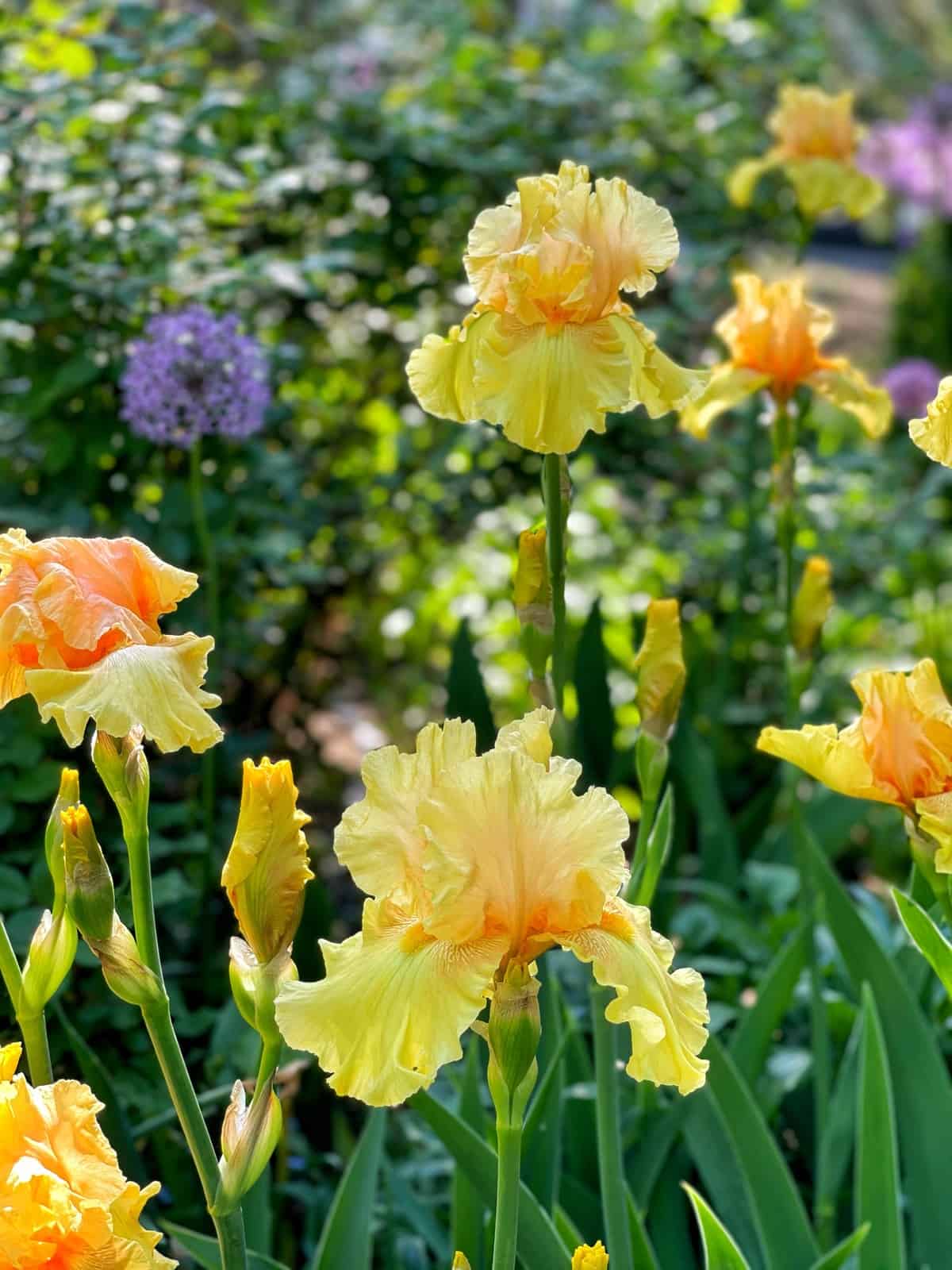
How to Grow an Easy-Care Cottage Garden
As with any low-maintenance garden, keep the basics in mind when you design, plant, and grow your garden. Here are a few tips for growing a cottage garden with success.
Choose the Right Location
Before you start planting, consider the location of your English style garden. Most cottage garden flowers thrive in areas with full sun or partial shade, and in soil that is well-draining and rich in organic matter.
It needs to be located in an area that’s easy for you to access that’s close to a water source. But be mindful of planting flowers that will thrive in the soil you have. For example, if you have soil that doesn’t drain well and retains moisture, lavender won’t do as well there.
So I recommend getting a soil test as the results will tell you what nutrients are present and lacking, as well as how to improve it.

Start With Good Soil
The best gardens start with high-quality soil. But soil preparation is often one of the most overlooked steps to growing a healthy garden.
Before planting your garden, take some soil samples and have them tested so you know what amendments your soil needs to grow healthy plants. You can purchase soil test kits online or find them at your local garden nursery.
Consider adding compost and other organic matter like leaf mold to your garden, too. You can buy bags of compost at the local nursery, but it’s also very easy (and more budget- and eco-friendly) to make your own with a simple compost recipe.

Plant a Mix of Annuals, Perennials, Bulbs, and Flowering Shrubs
To create a garden that is full of color and interest throughout the growing season, plant a mix of annuals, perennials, spring flowering bulbs, and shrubs.
Annuals will provide a burst of color in the first year, while perennials will come back year after year. Planting spring flowering bulbs will kick the garden off in early spring with little to no work from you after planting.
It’s also a good idea to plant flowering shrubs with foliage that provides seasonal interest and small evergreen trees and shrubs for additional structure and year-round color.
Just make sure you keep the overall size at maturity in mind before planting. It might look small at the nursery, but that shrub will grow!
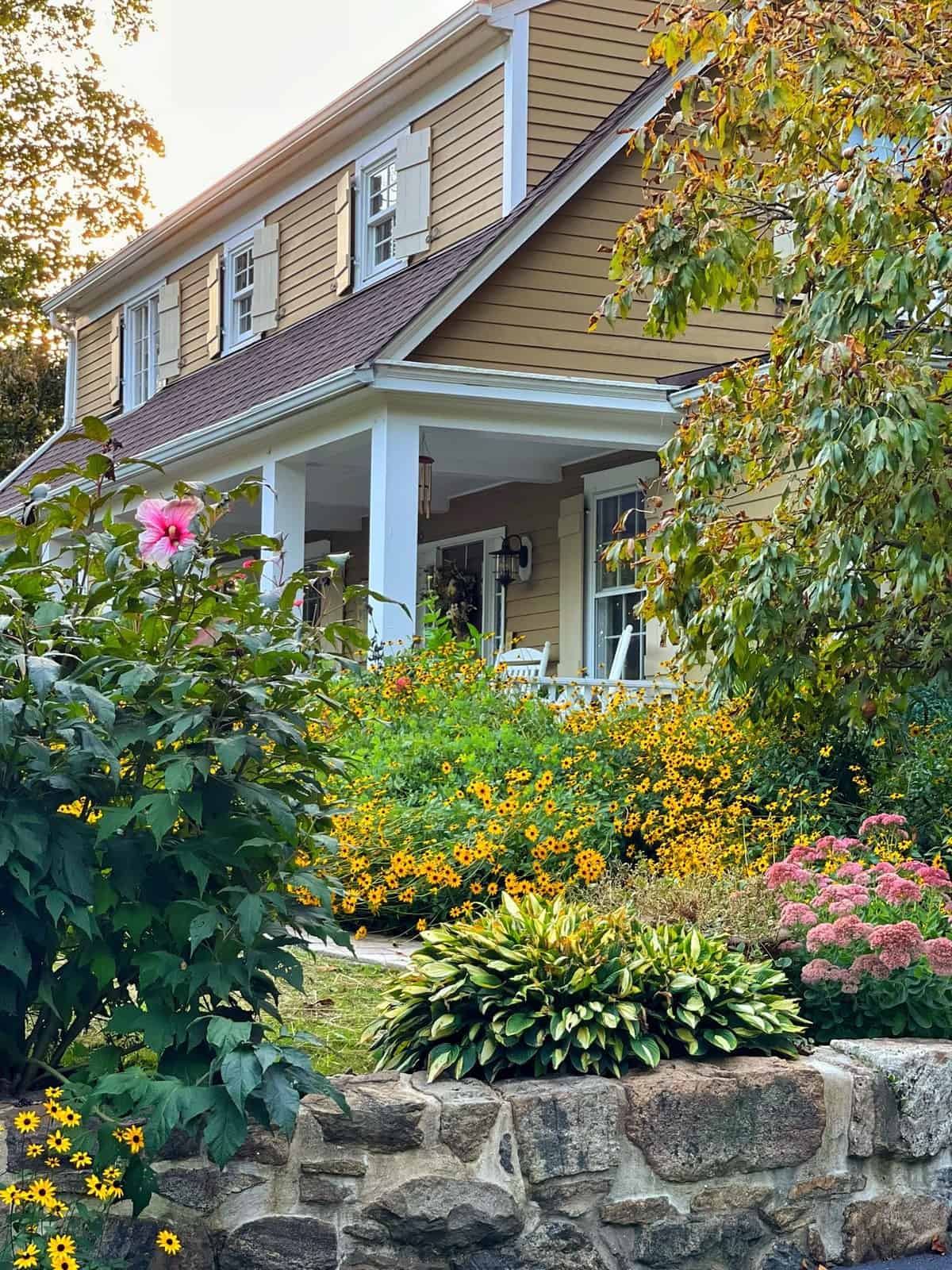
Consider Your Climate
Different plants are suited to different climates, so it’s important to consider your local conditions when selecting plants for your cottage garden. Know your hardiness zone and look for plants that are native to your area or that are known to thrive in similar conditions.
Embracing native plants that have a cottage garden style is a great way to grow an old English garden without the fuss. Because plants that are native to your locality have been growing there for a very long time. They are used to the weather conditions making them very low-maintenance options.
If you aren’t sure what’s native, reach out to your local cooperative extension and check plant tags at the garden nursery as some are labeled.

Keep Up on the Weeds
All gardens grow weeds. There’s just no way around them. While there are things we can do to prevent them from popping up, we still need to pull them as we see them so they don’t get out of control and take over your garden flowers. Cause trust me, that has happened to me before and I don’t recommend waiting to weed.
Here are a few ideas to help suppress weeds in your cottage garden without the need to pull them.
- Mulching your garden early in the growing season can help to retain moisture, suppress weeds, and regulate soil temperature.
- Plant flowers a little closer together to help choke out the weeds.
- Apply corn gluten around the beds when crabgrass germinates in spring. This is typically when the forsythia start to bloom for about two weeks after. You can learn more about how to apply corn gluten here.
- Spread layers of newspaper or cardboard beneath mulch to smother weeds and keep them at bay. This usually lasts about a season. But the benefit is, both will break down and enrich the soil.
Avoid using weed fabric as they don’t work well in flower gardens. They make it more difficult for flowers to spread, grow, and mature over time.
Because it never breaks down, it will always be there and if you want to plant more in the garden, you’ll need to cut through it so it’s more laborious. I also find weeds grow on top of the fabric so it’s not really worth it in the long run.
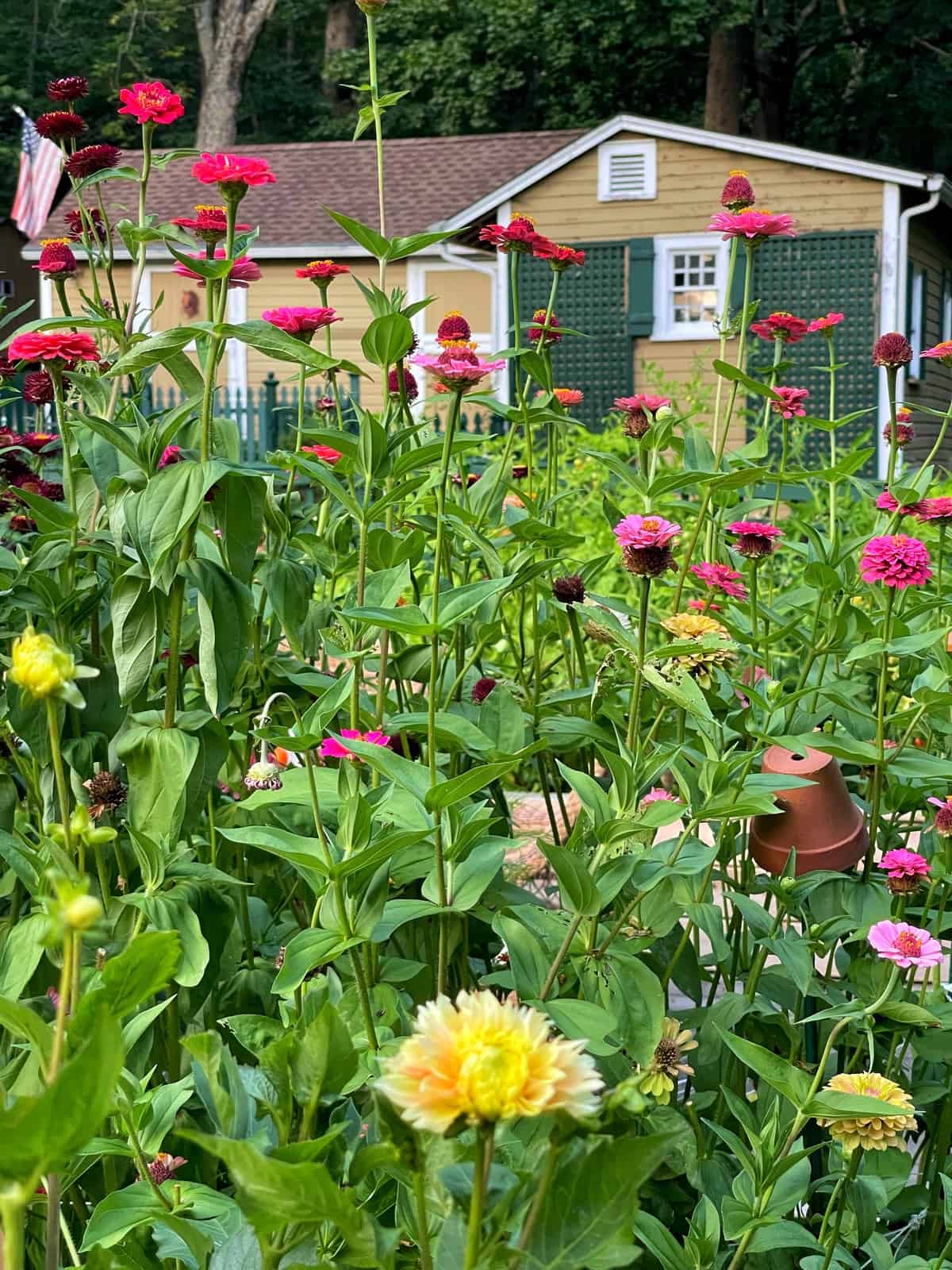
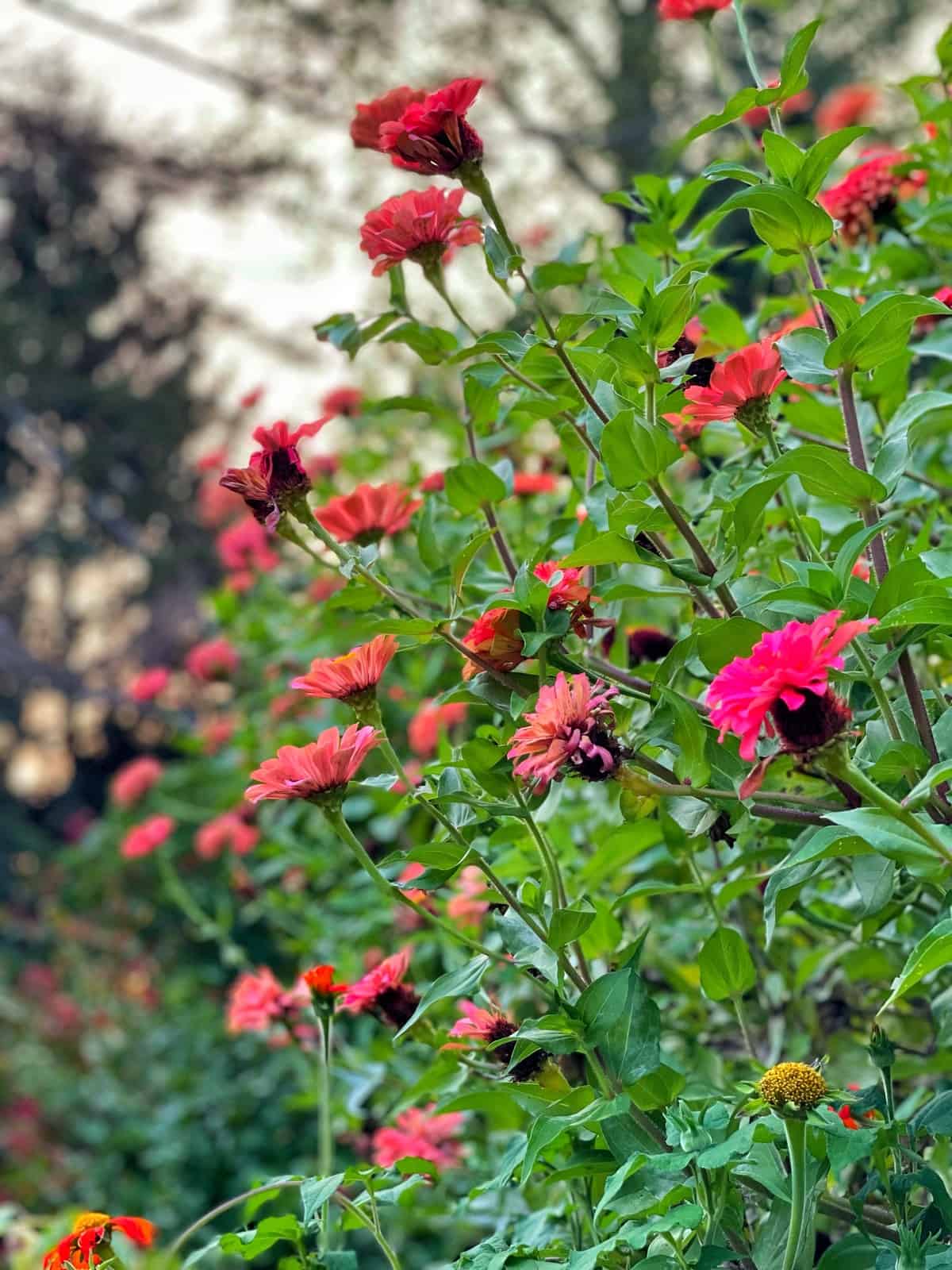
Mulch Your Garden Beds
Adding mulch to your cottage garden beds after planting helps suppress weeds but also breaks down over time and amends the soil too. Covering your soil can also help protect your flowers’ roots from any unexpected cold and helps your garden look more put together and finished (without making it high-maintenance).
Water Your Cottage Garden Regularly
Water your plants regularly, taking care not to overwater, as this can lead to pest and disease problems. I tend to let the elements take care of my flower gardens. However, when we experience hot, dry summers with little to no rain, I supplement with long, deep watering a few times a week. Drip irrigation set on timers are a great idea if you want to water with a set-and-forget approach.
Fertilize Annuals and Container Gardens
To keep your annual flowers and outdoor planters healthy with abundant blooms, it’s necessary to fertilize them on a regular basis. You can opt for a liquid fertilizer which usually lasts about a week or you can apply a slow-release fertilizer that lasts a few months. I recommend using the latter and setting a reminder on your phone to reapply when the package directions say it will expire.
Perennials, shrubs and trees do not need to be fertilized. Instead, focus on providing them with good soil that is rich in organic matter. Add compost and leaf mold to your gardens to improve the overall soil quality.

Deadhead and Prune When Needed
You can also prune your plants to encourage new growth and remove any dead or diseased branches. This will neaten up your garden’s appearance while keeping your plants healthy and looking beautiful. But not all plants need to be deadheaded or pruned. So read the plant tags and know before you grow.
If you want to grow a cottage garden that’s a little less work, opt for plants that bloom long like nepeta, salvia, sedum autumn joy and hydrangeas, and don’t require as much maintenance in terms of deadheading flowers and pruning.

Monitor for Pests and Diseases
And finally, walk your cottage gardens every single day. It’s not only joyful to do as you want the plants grow and change, but you’ll notice pest and disease problems much sooner that may affect your plants before it gets out of control.
Look for nibbles on plants, insects, and diseased foliage. Never blindly apply pesticides from the nursery without knowing what the problem is on a plant because not all pesticides, both organic and synthetic control or cure the same things.
When problems arise that you are unsure of, reach out to your local cooperative extension and speak with a master gardener to help you best identify garden problems and how to solve them.
Attract Beneficial Insects
While you’ll want to keep some bugs away from your plants, one of the best low-maintenance cottage garden ideas is to purposefully attract pollinators and other beneficial insects. By bringing bees, ladybugs, butterflies, and hummingbirds to your flower garden, you can help maintain a healthy ecosystem and reduce unwanted pest problems. These pollinators also help spread seed so your gardens grow more and more full each year.
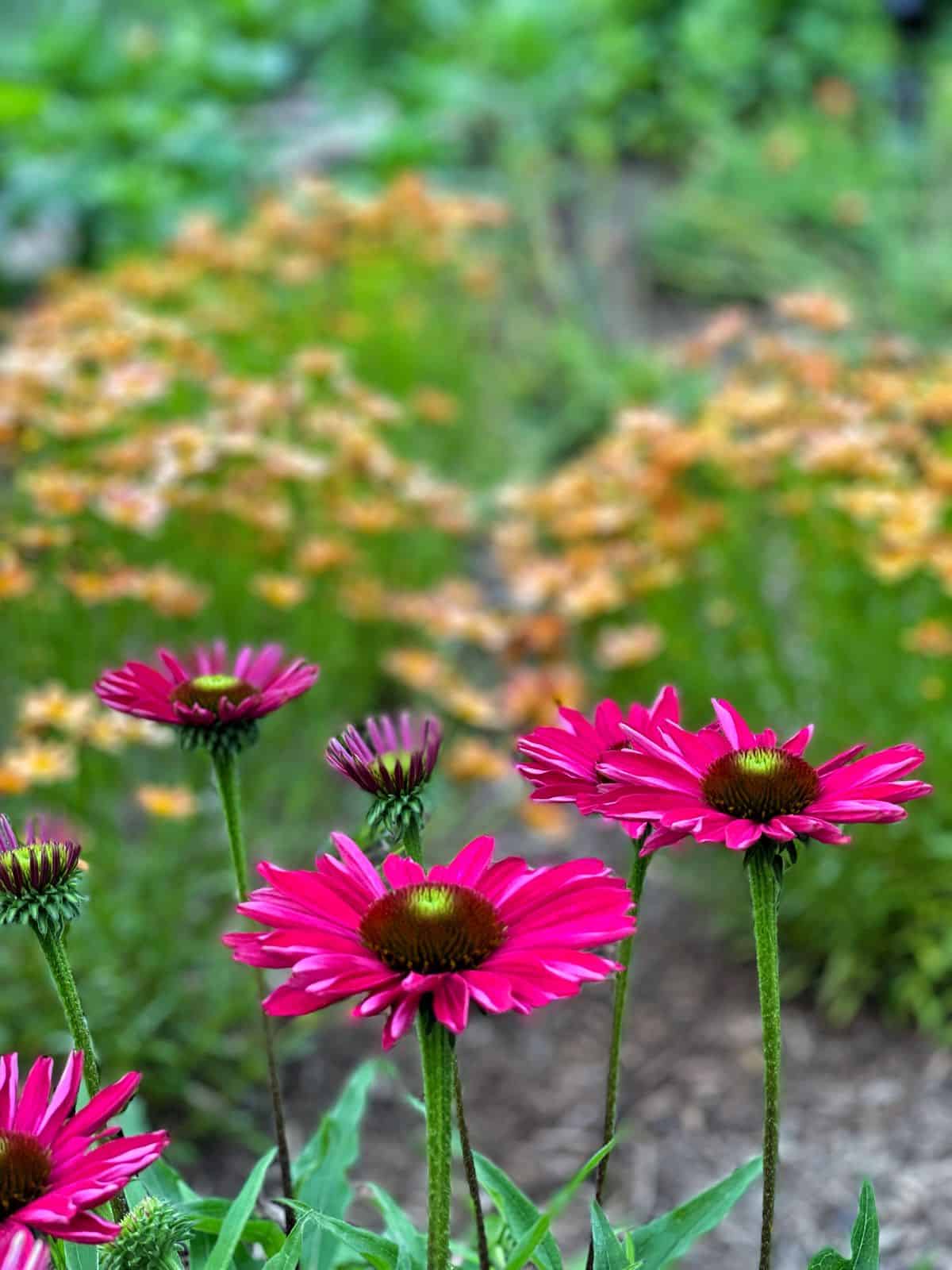
Avoiding Cottage Garden Missteps: Key Tips for Success
While cottage gardens embrace a relaxed charm, a few missteps can hinder their potential. Here’s what to keep in mind:
- Space Wisely: Resist the urge to overcrowd. Allow ample room for each plant to flourish and avoid a chaotic appearance.
- Watch the Sunlight: Match plants to their sunlight needs (full sun, part sun, or shade) for optimal growth and flowering.
- Nurture the Soil: Prepare your soil with compost or other organic matter to ensure it’s rich and well-draining.
- Water Mindfully: Avoid both overwatering and underwatering. Check soil moisture regularly and water deeply but less often.
- Choose Wisely: Research plant choices to avoid invasive species that could take over your garden.
- Deadhead Regularly: Remove spent blooms to encourage continuous flowering and maintain a tidy look.
- Vary Plant Heights: Incorporate a mix of tall, medium, and low-growing plants to create a visually appealing layered effect.
By following these tips, you’ll set your cottage garden up for success and enjoy a flourishing and beautiful space with minimal effort.

Cottage Garden Design FAQs
Still have questions about creating your own low-maintenance cottage garden designs? Read answers to some of the most common questions about easy-care gardening.
What are the best colors for a cottage garden?
Cottage gardens are known for their vibrant and diverse color palettes. While you can certainly choose a color theme if you want one, a great thing about cottage gardens is they can be informal, natural, and even a little wild.
Some of my favorite colors to include in blooms for a cottage garden include:
- Soft pastels like lavender, pink, and baby blue
- Bright, cheerful hues such as yellow, orange, and red
- Plenty of fresh green in varying shades
- White flowers to create contrast against colorful blooms.

What herbs are good for cottage gardens?
Herbs are excellent additions to cottage gardens and a traditional part of Old English gardens. Some popular herbs for cottage gardens include:
- Lavender
- Rosemary
- Thyme
- Sage
- Chamomile
- Basil
All of these herbs have soft colors and foliage that is both beautiful and fragrant.
Can I grow vegetables in a cottage garden?
Absolutely! Many cottage gardens include edibles like lettuce, tomatoes, peppers, and herbs. The key is to intermingle them with flowers for a beautiful and productive space.
What are the easiest flowers to grow in a cottage garden?
While there are lots of flowers for a cottage garden to choose from, here are some of the easiest and most popular flowers for cottage gardens include:
- Black-eyed Susans: Bright yellow daisies that attract pollinators.
- Sedum Autumn Joy: Succulent-like plants with pink blooms that turn coppery in fall.
- Zinnias: Colorful annuals that come in a wide range of hues.
- Gomphrena: Long-lasting, globe-shaped flowers in shades of purple, pink, and white.
- Coneflowers: Purple or pink blooms with a prominent cone-shaped center.

How much maintenance do cottage gardens need?
Cottage gardens can vary in their maintenance requirements depending on factors like plant selection, garden size, and climate. But generally, cottage gardens are designed to be low-maintenance compared to formal gardens.
With proper planning and plant selection, cottage gardens can thrive with minimal upkeep. Routine tasks such as watering, deadheading spent blooms, occasional pruning, and weeding will still be necessary to keep the garden looking its best. But the relaxed style of cottage gardens means they can tolerate a bit of untidiness and imperfection, making them ideal for busy gardeners or beginners.
As you practice and learn as you grow things, you’ll gain experience and become a better gardener with a bed of blooms that flower all season long.

Final Thoughts About Easy-Care Garden Ideas
In conclusion, a low-maintenance cottage garden is a great option for busy gardeners who want to enjoy the beauty of flowers without having to spend a lot of time on care. By using perennial flowers, annuals, herbs, and even vegetables, you can create a colorful and vibrant garden that will require less maintenance than a traditional garden.
Some easy-care perennial flowers that are perfect for cottage gardens include black-eyed susans, sedum autumn joy, and coneflowers. Other tips for creating a low-maintenance cottage garden include using a mix of plants, planting in odd numbers, and incorporating evergreens.
With a little planning and effort, you can create a beautiful and low-maintenance cottage garden that will bring you joy for years to come.
For mor information about cottage gardening, please read this article from North Carolina State University Cooperative Extension.
Are you growing a cottage garden too? What are your favorite plants to include? I would love to know more in the comments below.
If you have any questions, comments or suggestions, please let me know in the comments below. I’d love to hear! And feel free to share this post with anyone you think would find it helpful too.
Thanks so much for dropping by the blog today.
I hope you are inspired to grow your own cottage garden! Happy Gardening! xo
Pin It to Remember It Later

Thank you so much for following along.
Enjoy a beautiful day! xo


